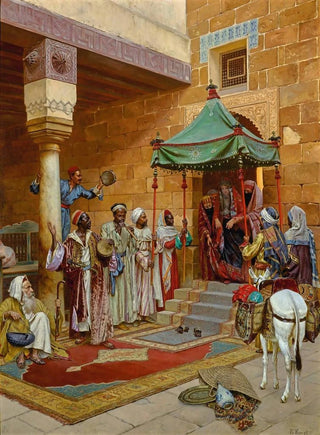Art print | The new bride - Rudolf Ernst


View from behind

Frame (optional)
In the fascinating world of art, some works manage to capture the very essence of an era, a culture, or an emotion. "The New Bride" by Rudolf Ernst is one of those creations that transports the viewer to the heart of a vibrant scene full of life and tradition. Painted at the end of the 19th century, this piece not only showcases the undeniable talent of the artist but also depicts a significant moment in the social and cultural life of its time. The scene portrays a young bride, radiant in her traditional attire, surrounded by symbolic elements that evoke both the joy and solemnity of a commitment. Gazing at this art print, the eye is immediately drawn to the brilliance of the colors and the richness of the details, inviting a complete immersion into Ernst's universe.
Style and uniqueness of the work
Rudolf Ernst's style is distinguished by its meticulous realism and sharp sense of visual storytelling. "The New Bride" is no exception to this rule. The artist succeeds in capturing not only the external appearance of his subjects but also the intensity of their emotions. Every fold of the dress, every accessory, every exchanged look between the characters tells a story. The light, skillfully orchestrated, plays a crucial role in the composition, creating delicate shadows that add striking depth to the scene. The use of vivid colors, combined with softer shades, enhances the festive atmosphere while maintaining a certain intimacy. This work is a true masterpiece that transcends a simple portrait to become a celebration of culture and traditions, paying tribute to the beauty of wedding rituals.
The artist and his influence
Rudolf Ernst, born in 1854 in Vienna, is an artist whose work is often associated with the Orientalist movement. His fascination with Eastern cultures, which he explored during his travels, is reflected in his paintings, where he skillfully blends Western and Eastern elements. Ernst is recognized for his ability to depict scenes of daily life with meticulous attention to detail and sensitivity to cultural nuances. His influence is perceptible

Matte finish

View from behind

Frame (optional)
In the fascinating world of art, some works manage to capture the very essence of an era, a culture, or an emotion. "The New Bride" by Rudolf Ernst is one of those creations that transports the viewer to the heart of a vibrant scene full of life and tradition. Painted at the end of the 19th century, this piece not only showcases the undeniable talent of the artist but also depicts a significant moment in the social and cultural life of its time. The scene portrays a young bride, radiant in her traditional attire, surrounded by symbolic elements that evoke both the joy and solemnity of a commitment. Gazing at this art print, the eye is immediately drawn to the brilliance of the colors and the richness of the details, inviting a complete immersion into Ernst's universe.
Style and uniqueness of the work
Rudolf Ernst's style is distinguished by its meticulous realism and sharp sense of visual storytelling. "The New Bride" is no exception to this rule. The artist succeeds in capturing not only the external appearance of his subjects but also the intensity of their emotions. Every fold of the dress, every accessory, every exchanged look between the characters tells a story. The light, skillfully orchestrated, plays a crucial role in the composition, creating delicate shadows that add striking depth to the scene. The use of vivid colors, combined with softer shades, enhances the festive atmosphere while maintaining a certain intimacy. This work is a true masterpiece that transcends a simple portrait to become a celebration of culture and traditions, paying tribute to the beauty of wedding rituals.
The artist and his influence
Rudolf Ernst, born in 1854 in Vienna, is an artist whose work is often associated with the Orientalist movement. His fascination with Eastern cultures, which he explored during his travels, is reflected in his paintings, where he skillfully blends Western and Eastern elements. Ernst is recognized for his ability to depict scenes of daily life with meticulous attention to detail and sensitivity to cultural nuances. His influence is perceptible






